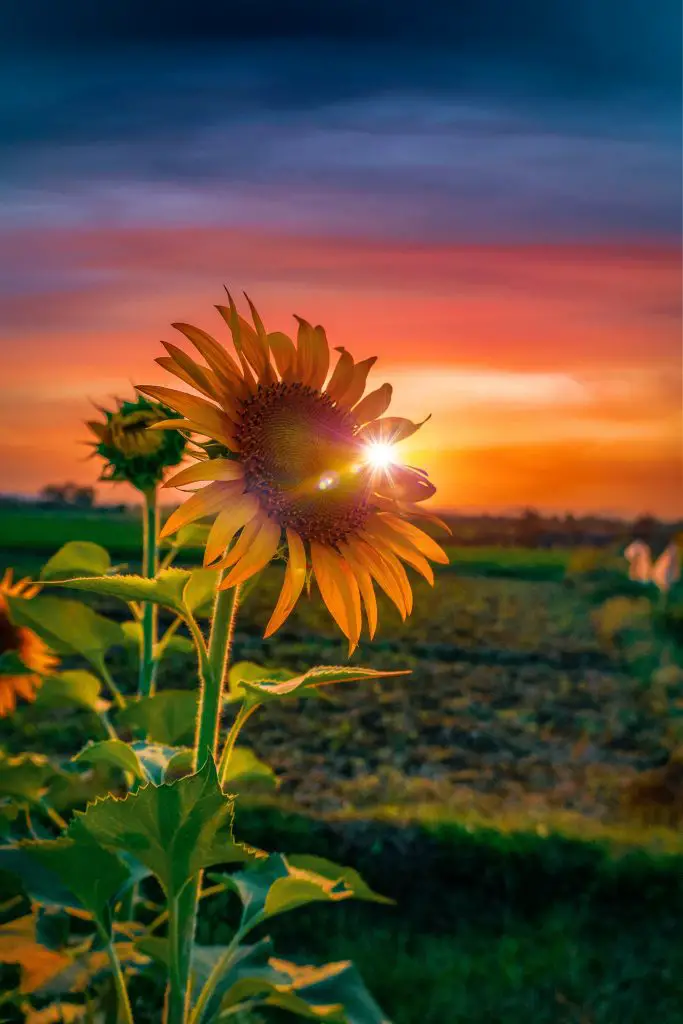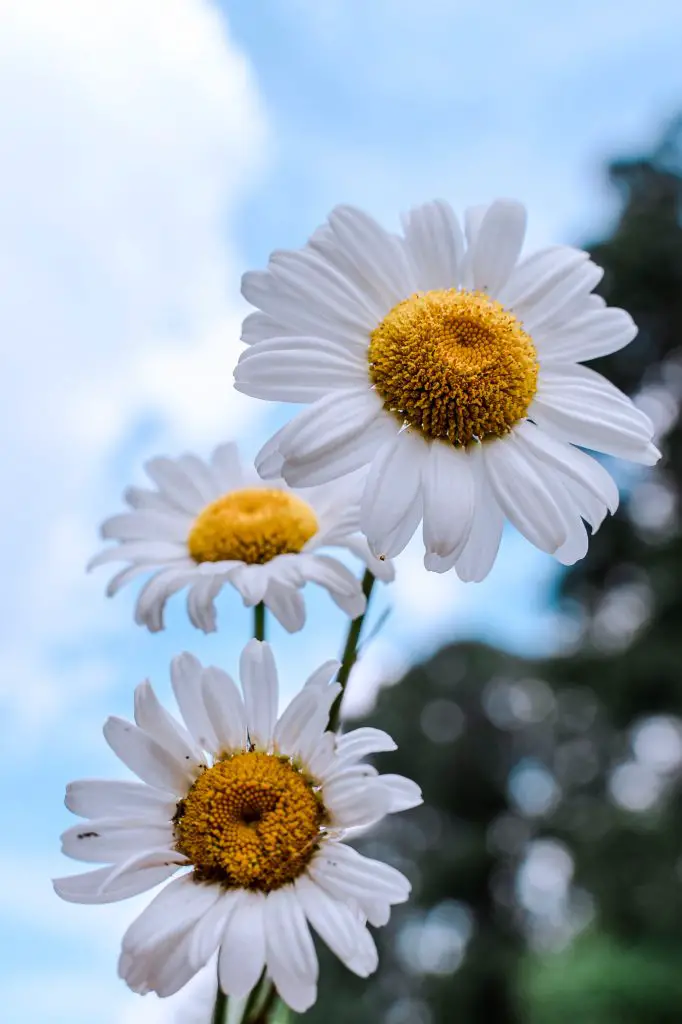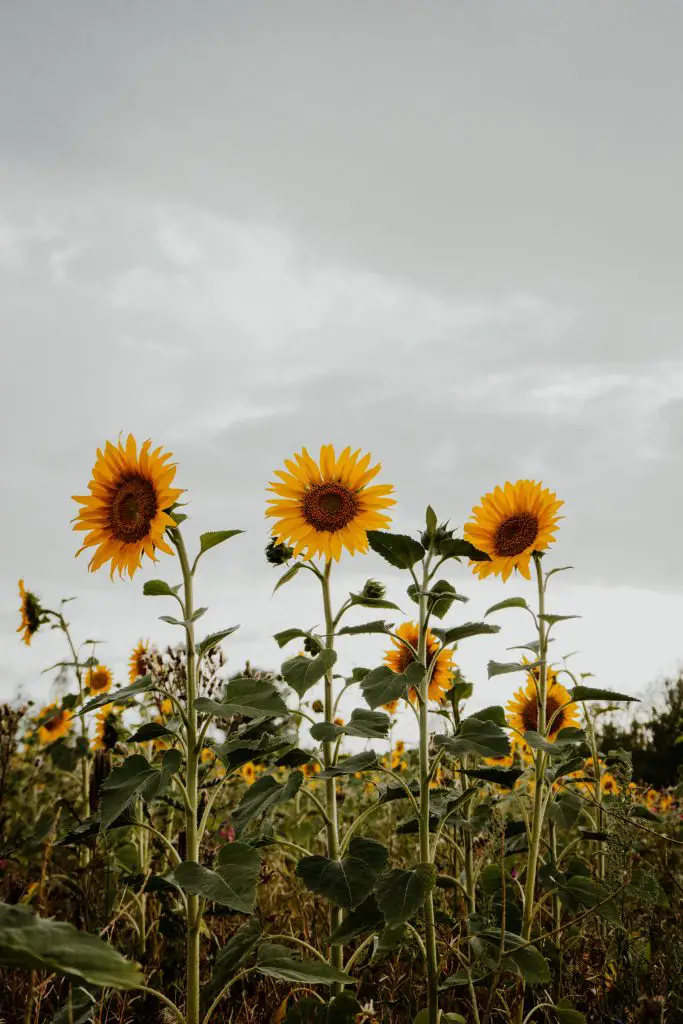What’s The Difference Between A Daisy And A Sunflower? Daisy and sunflowers are among the most beautiful plants that you can put in a garden. They are bright and colorful and provide a striking display during summer but what is the difference between these plants?
Sunflowers differ significantly from daisies because the most common varieties are annual plants that produce a single flower on top of a tall stalk. The size of the flower produced can be as large as a dinner plate and over 6 ft tall, though this does vary significantly depending upon the variety. Whereas daisies are perennial shrubs that can vary in height significantly and produce many small flowers on the plant.
Both plants come from the aster family, which is sometimes referred to as the daisy family. The sunflowers come from the Helianthus genus which comprises of approximately 70 different species whereas in the case of daisies there is a range of different species that are referred to as daisies that come from a range of different genus’.

These include a range of species some of which are listed below. However, if you are looking to find the perfect daisy for your plants I would recommend visiting www.gardenia.net it is a terrific resource that has a lot of information on what the individual cultivars look like and the growing conditions they prefer.
- African Daisy – The plant is also know as Osteospermum and originated in Africa.
- Ageratum – Ageratum orginated in Mexico and has a slightly differnet form to many other daisy species with soft, round, fluffy flowers. This plant is only suitable in zones 10 to 11.
- Anthemis – The plant is also known as Mayweed or Chamomile has white petals with a yellow center.
- Arctotis Acaulis – This plant is perennial in warm climates and is often grown as an annual. The plant has a range of cultivars with orange, yellow, and magenta flowers.
- Arctotis Aspera – This is a perennial plant that produces flowers for much of the year and is highly drought tolerant once it is established.
- Arctotis Grandis – This plant is also known as the “Blue-Eyed African Daisy” because it has white petals with a blue center.
- Arctotis revoluta – Is a tough fast-growing shrub that is suited for coastal and rock gardens.
- Argyranthemum – Argyranthemum is one of the few annual daisies that produces a bright yellow flower that is ideal of attracting pollinating insects to your garden.
- Aster – Asters have bright yellow center with petals that are pink, purple, or white. They are suited to zone 3 to 8.
- Barberton Daisy – The Barberton daisy is sometimes referred to as the Gerbera daisy and comes in a range of colors.
- Canary Island Marguerite – This plant is sometimes referred to as the Canary Island Marguerite or Royal Haze. It has a blue-green foliage and the flowers have a typical daisy appearance it is suited to growing in Zone 3 to 8.
- Cape marguerite – The plant produces a yellow, white or purple single petal flowers that are ideal for attaching pollinators.
- Chrysanthemum indicum – This plant is grown as both annual and as a perennial plant that is only suited to zones 7 to 12.
- Chrysanthemum morifolium – This plant comes in a wide range of colours which include orange, pink, yellow, red, white, and purple. The plant can grow outdoors in zone 10 & 11.
- Coneflower – This plant is also known as Echinacea and is available in a wide range of colours.
- Coreopsis – Coreopsis is a drought tolerant plant that produces yellow flowers that bloom for a long period of time. The plant is suited to zone 4 to 10.
- English Daisy Coreopsis – This plant has a yellow disk-like center surrounded by red, white, or pink petals. They easily reseed readily and are suitable for growing in zones 4 to 10.
- Gerbera Daisy – Gerbera Daisies are often grown as cut flowers. They com is a range of colours including white, pink, yellow, orange, purple, and Red.
- Marguerite Daisy – The Marguerite Daisy is a perennial shrub that flowers in summer and spring producing white, yellow, and pink flowers. It is suited to growing in Zone 9 to 11.
- Monoptilon Bellidiforme – This plant is also known as the Daisy Desertstar and it thrives in sandy desert habitats and thrive in dry climates.
- Oxeye Daisy – The Oxeye Daisy has a yellow eye surrounded by white petals. It is considered invasive in some environments as needs to be controlled.

About Sunflowers
Plants from the Helianthus genus originated in the Americas and are believed to have been first domesticated in the southern part of the United States and Mexico approximately 4000 years ago. The plants were used by Native Americans as a source for edible seeds.
However, the plants did not appear in Europe until the early part of the 16th century. The plants were developed and hybridized to produce cultivars that were suitable for the production of sunseed oil. Sunseed oil quickly became a useful commodity in cooking and cosmetics resulting in the cultivation of the plant on an industrial scale in places like Russia, which to this day is the largest producer in the world.
Due to the extensive breeding programs that occurred there have been a range of hybrid plants created that now come in a range of colors which include yellow, red, orange, and cream. There is also a significant variation in the height of plants with some varieties being up to 8 ft tall or as short as 1 ft tall.
The plants within this genus also come in both annual and perennial varieties. The annual varieties, which tend to be the most commonly associated with sunflowers are generally taller than the perennial varieties and produce often a single large flower. The size of the flower usually increases with height.
Additionally, due to the annual nature of the plant, it can also be grown in a wider number of regions than the perennial varieties which need to survive the winter. Annual varieties can be grown from zones 2 to 11 whereas perennial varieties typically are hardy in zone 5 to 11.
To maximize the regions over which the plant can be grown sunflower plants also have some interesting adaptions which help them to develop more quickly during the early part of the growing season. The plants’ flower head tracks the sun throughout the day to increase the amount of sunlight it receives maximizing the rate of growth.

How To Grow Sunflowers
The annual plants with the sunflower genus are fast-growing plants that will produce a flower in 80 to 100 days. Due to the speed of growth and the size of the seed the plants are best sown directly in the soil in mid-spring after the risk of frost has passed. The seeds should be planted at a depth of 1 inch approximately 1.5 to 2 ft apart.
When selecting a location to plant the seeds it is important that it is a warm sunny location with ideally moist, well-drained soil with plenty of nutrients. However, sunflower plants are generally tolerant of most soil conditions except those that are extremely wet as there is a risk that the seeds will rot.
The other consideration is the wind. As many of the annual sunflower plants are tall it is advisable to select a sheltered location to avoid having the plants topple over in the wind.
Once the seed has been planted it is a good idea to apply a thick layer of mulch and water the plants well. The seedlings will emerge relatively quickly. If the variety being grown is relatively tall it is advisable to stake the plant with a single bamboo stake to stop the plant from falling over.
In the case of perennial sunflower varieties planting can be done in either spring or autumn. If you plant in spring you will get flowers in the first season just like with the annual varieties. As perennial varieties will get larger year on year it is advisable to divide them every 2 to 3 years. This will ensure that they continue to produce vigorous growth year on year.
